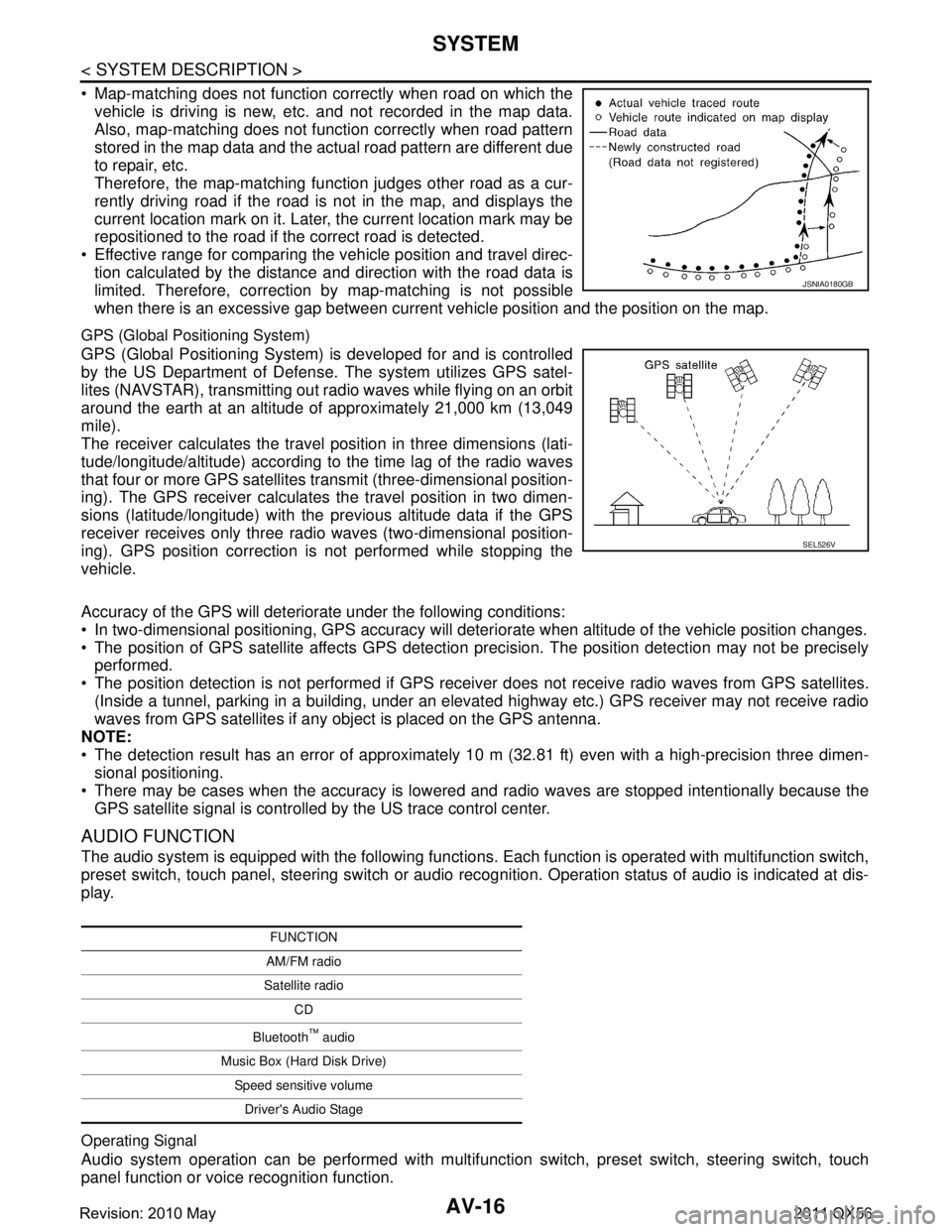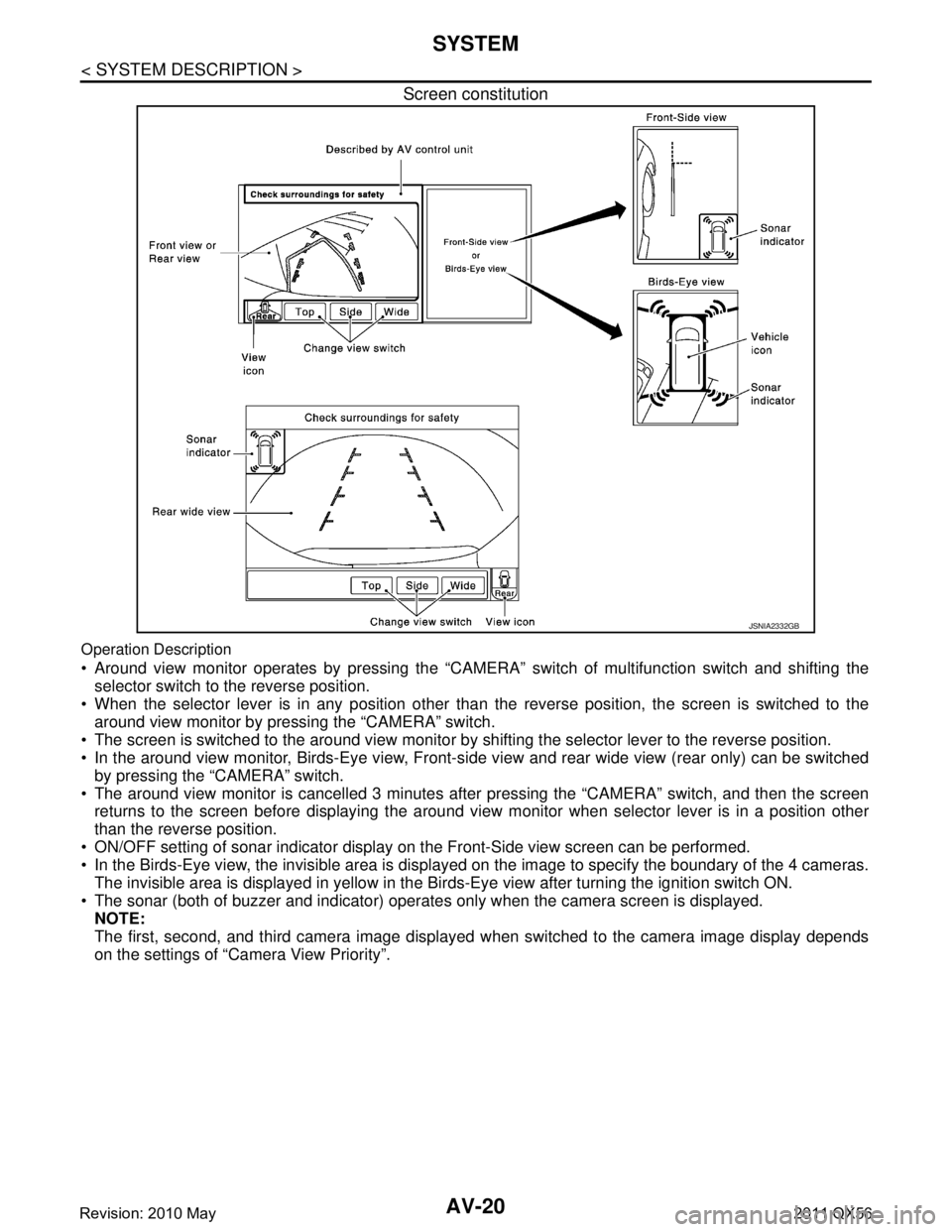display INFINITI QX56 2011 Factory Owner's Manual
[x] Cancel search | Manufacturer: INFINITI, Model Year: 2011, Model line: QX56, Model: INFINITI QX56 2011Pages: 5598, PDF Size: 94.53 MB
Page 159 of 5598

AV
COMPONENT PARTSAV-11
< SYSTEM DESCRIPTION >
C
DE
F
G H
I
J
K L
M B A
O P
Video distributor It receives the image signal and sound signal from the AV control unit and then
transmits it to the headrest display unit.
It receives the image signal and sound signal from the auxiliary input jacks and then transmits it to the headrest display unit.
Switches image and sound output to headrest display unit, inputting image switch
signal from headrest display unit via hard wire.
Front auxiliary input jacks Image signal and sound signal of auxiliary input is transmitted to AV control unit.
Rear auxiliary input jacks
(Mobile entertainment system) Image signal and sound signal of auxiliary input is transmitted to video distributor.
BOSE amp. Inputs sound signal from AV control unit, and outputs sound signal to each speaker.
Front door speaker Outputs sound signal from BOSE amp.
Outputs high, mid and low range sounds.
Rear door speaker Outputs sound signal from BOSE amp.
Outputs high, mid and low range sounds.
Squawker Outputs sound signal from BOSE amp.
Outputs high and mid range sounds.
Rear door tweeter Outputs sound signal from BOSE amp.
Outputs high range sounds.
Roof speaker Outputs sound signal from BOSE amp.
Outputs high and mid range sounds.
Center speaker Outputs sound signal from BOSE amp.
Outputs high and mid range sounds.
Woofer Outputs sound signal from BOSE amp.
Outputs low range sounds.
Multifunction switch Operation panel is equipped with the centralized switch where audio, auxiliary in-
put and navigation, etc. operations are integrated.
Connected with preset switch via hardwire and operation signal is transmitted to AV control unit via AV communication.
Preset switch Operation panel is equipped with the centralized switch where audio and air con-
ditioner, etc. operations are integrated.
Connected with multifunction switch via hardwire, and operation signal is transmit- ted to AV control unit via AV communication.
The disk ejection operating signal is performed by hardwire.
Steering switch Operations for audio, hands-free phone and navigation, etc. are possible.
Steering switch signal (operation signal) is output to AV control unit.
Around view monitor control unit It supplies power to front camera, rear camera, and side camera. And then it su-
perimposes the images from each camera and outputs them to front display unit.
Superimpose the guiding line, predicted course line and sonar indicator to the
camera image that outputs to front display unit.
It performs the reception/transmission of communication signal with each camera.
It transmits the sonar operation signal from sonar control unit and receives the so- nar information from sonar control unit via AV communication.
It transmits the information received/transmitted with sonar control unit via AV communication to AV control unit.
Front camera It inputs the power supply from around view monitor control unit and outputs the
image of the vehicle front to around view monitor control unit.
It performs the reception/transmission of the communication signal with around view monitor control unit.
Rear camera It inputs the power supply from around view monitor control unit and outputs the
image of the vehicle rear to around view monitor control unit.
It performs the reception/transmission of the communication signal with around view monitor control unit.
Side camera LH It inputs the power supply from around view monitor control unit and outputs the
image of the vehicle LH to around view monitor control unit.
It performs the reception/transmission of the communication signal with around view monitor control unit.
Part name Description
Revision: 2010 May2011 QX56
Page 162 of 5598

AV-14
< SYSTEM DESCRIPTION >
SYSTEM
MULTI AV SYSTEM : System Description
INFOID:0000000006216216
Multi AV system means that the following systems are integrated.
COMMUNICATION SIGNAL
AV control unit function by transmitting/receiving dat a one by one with each unit (slave unit) that configures
them completely as a master unit by connecting between units that configure MULTI AV system with two AV
communication lines (H, L).
Two AV communication lines (H, L) adopt a twisted pair line that is resistant to noise.
AV control unit is connected by CAN communication, and it receives data signal from ECM and combination
meter It computes and displays fuel economy information value with the obtained information. Transmitting/
receiving of data signal is performed by BCM. Also, it transmits the required signal of vehicle setting and
receives the response signal.
AV control unit is connected with front display unit and serial communication, and it transmits the required
signal of display and display control and receives the response signal from front display unit.
NAVIGATION SYSTEM FUNCTION
Description
The AV control unit controls navigation function whil e GPS tuner has built-in map data, GYRO (angle speed
sensor), on the HDD (Hard Disk Drive).
The AV control unit inputs operation signal with communication signal, through display (touch panel) and multifunction switch and steering switch.
Guide sound is output to front speaker through BOSE am p. from AV control unit when operating navigation
system.
A vehicle position is calculated with the GYRO (angl e speed sensor), vehicle sensor, signal from GPS satel-
lite and map data stored on HDD (Hard Disk Drive), and transmits the map image signal (RGB image, RGB
area, RGB image synchronizing) to the display.
Position Detection Principle
The navigation system periodically calculates the current vehicle
position according to the following three types of signals.
Travel distance of the vehicle as determined by the vehicle speed
sensor
Vehicle turning angle determined by the gyroscope (angular speed
sensor)
The travel direction of the v ehicle determined by the GPS antenna
(GPS information)
The current position of the vehicle is then identified by comparing the
calculated vehicle position with map data, which is stored in the HDD
(Hard Disk Drive) (map-matching), and indicated on the screen with
a current location mark. More accurate data is used by comparing
position detection results from GPS to the map-matching.
FUNCTION NAME
Navigation system function Audio function
DVD play function
Front auxiliary input function USB connection function
Mobile entertainment system Hands-free phone function Touch panel function
Around view monitor function
Camera assistance sonar system Vehicle information function
Auto Light adjustment system
JSNIA0177GB
Revision: 2010 May2011 QX56
Page 164 of 5598

AV-16
< SYSTEM DESCRIPTION >
SYSTEM
Map-matching does not function correctly when road on which thevehicle is driving is new, etc. and not recorded in the map data.
Also, map-matching does not function correctly when road pattern
stored in the map data and the actual road pattern are different due
to repair, etc.
Therefore, the map-matching func tion judges other road as a cur-
rently driving road if the road is not in the map, and displays the
current location mark on it. Later, the current location mark may be
repositioned to the road if t he correct road is detected.
Effective range for comparing the vehicle position and travel direc- tion calculated by the distance and direction with the road data is
limited. Therefore, correction by map-matching is not possible
when there is an excessive gap between current vehicle position and the position on the map.
GPS (Global Positioning System)
GPS (Global Positioning System) is developed for and is controlled
by the US Department of Defens e. The system utilizes GPS satel-
lites (NAVSTAR), transmitting out radio waves while flying on an orbit
around the earth at an altitude of approximately 21,000 km (13,049
mile).
The receiver calculates the travel position in three dimensions (lati-
tude/longitude/altitude) according to the time lag of the radio waves
that four or more GPS satellites transmit (three-dimensional position-
ing). The GPS receiver calculates the travel position in two dimen-
sions (latitude/longitude) with the previous altitude data if the GPS
receiver receives only three radio waves (two-dimensional position-
ing). GPS position correction is not performed while stopping the
vehicle.
Accuracy of the GPS will deteriorate under the following conditions:
In two-dimensional positioning, GPS accuracy will det eriorate when altitude of the vehicle position changes.
The position of GPS satellite affects GPS detection pr ecision. The position detection may not be precisely
performed.
The position detection is not performed if GPS receiver does not receive radio waves from GPS satellites.
(Inside a tunnel, parking in a building, under an elevat ed highway etc.) GPS receiver may not receive radio
waves from GPS satellites if any object is placed on the GPS antenna.
NOTE:
The detection result has an error of approximately 10 m (32.81 ft) even with a high-precision three dimen- sional positioning.
There may be cases when the accuracy is lowered and radio waves are stopped intentionally because the GPS satellite signal is controlled by the US trace control center.
AUDIO FUNCTION
The audio system is equipped with the following functions. Each function is operated with multifunction switch,
preset switch, touch panel, steering switch or audio rec ognition. Operation status of audio is indicated at dis-
play.
Operating Signal
Audio system operation can be performed with multifuncti on switch, preset switch, steering switch, touch
panel function or voice recognition function.
JSNIA0180GB
SEL526V
FUNCTION
AM/FM radio
Satellite radio CD
Bluetooth
™ audio
Music Box (Hard Disk Drive) Speed sensitive volumeDriver's Audio Stage
Revision: 2010 May2011 QX56
Page 165 of 5598

AV
SYSTEMAV-17
< SYSTEM DESCRIPTION >
C
DE
F
G H
I
J
K L
M B A
O P
Operating signal is transmitted to AV control unit wit h AV communication when it is operated by multifunction
switch or preset switch. The disk ejection operating signal is performed by hardwire.
Operating signal is transmitted to AV control unit with steering switch signal when it is operated by steering
switch.
Screen Display
Switching of display is performed with serial comm unication between front display unit and AV control unit.
AM/FM Radio Mode
AM/FM radio tuner is built into AV control unit.
AM/FM radio wave is received by radio antenna, next it is amplified by antenna amp., and finally it is input to
AV control unit.
FM radio wave is received by FM sub antenna, and it is transmitted to the AV control unit directly.
Audio signal is input to BOSE amp. and BOSE amp. outputs to each speaker.
Satellite Radio Mode
Satellite radio tuner is built into AV control unit.
Sound signal (satellite radio) is received by satel lite radio antenna and transmitted to AV control unit. AV
control unit outputs sound signal to BOSE amp. The si gnal is also outputted from BOSE amp. to each
speaker.
CD Mode
CD function is built into AV control unit.
AV control unit outputs audio signal to BOSE amp., and BOSE amp. outputs to each speaker when CD is
inserted to AV control unit.
Bluetooth™ Audio Mode
Bluetooth™ audio function is built into AV control unit.
Bluetooth
™ audio can play music data in the portable audio by means of Bluetooth™ communications
between the portable audio and the AV control unit.
AV control unit outputs audio signal to BOSE amp., and BOSE amp. outputs to each speaker.
Music Box Mode
Music CD data is stored on HDD that is built into AV control unit, and it can be played.
AV control unit outputs music (sound signal) that is stored on HDD to BOSE amp., and BOSE amp. outputs
to each speaker.
Speed Sensitive Volume
Volume level of this system gone up and down autom atically in proportion to the vehicle speed.
The control level can be selected by the customer.
Driver's Audio Stage
Driver's Audio Stage controls the speaker's output characte ristic by BOSE amp. so that the driver's seat is to
be the center of sounds.
ON/OFF signals of Driver's Audio Stage are transmitt ed from AV control unit to BOSE amp. using mode
change signal.
DVD PLAY FUNCTION
DVD is played by inserting DVD into the AV control unit.
DVD image signals are transmitted to the front display unit, and DVD sound signals are transmitted to each
speaker via BOSE amp.
DVD image signals and sound signals are transmitted to the headrest display unit via the video distributor.
The headrest display unit transmits the sound signals to the headphone via infrared communication.
USB CONNECTION FUNCTION
Connecting iPod® or USB memory allows the driver to play iPod® music files or USB memory-stored music
files, video data, and image viewer data.
Sound signals of music files stored in iPod
® or USB memory are transmitted from the USB connector to the
AV control unit. The AV control unit transmits t he sound signals to the BOSE amp. and video distributor.
Sound signals transmitted from the BOSE amp. to each speaker, and sound signals transmitted from the
video distributor to headphone via headrest display unit
Video signals and image viewer file signals are transmitt ed from the USB connector to the AV control unit.
The data and files are displayed on the front display unit screen.
Revision: 2010 May2011 QX56
Page 166 of 5598

AV-18
< SYSTEM DESCRIPTION >
SYSTEM
Video signals are transmitted from the USB connector to the AV control unit. The data and files are displayed
on the headrest display unit screen.
iPod
® is recharged when connected to USB connector.
Only files that meet the following conditions will be played.
NOTE:
iPod
® is a trademark of Apple inc., regist ered in the U.S. and other countries.
Image signals cannot be received from iPod
®.
Use the enclosed USB harness when connecting iPod
® to USB connector.
If a video-sound codec combination is not satisfied, its video file may not be played.
Signals cannot be transmitted to video dist ributor under the following conditions:
- Only sound signal or only image viewer data is stored in iPod
®
- Only sound signal or only image viewer data is stored in USB memory
FRONT AUXILIARY INPUT FUNCTION
Image and sound can be output from an external devic e by connecting a device with front auxiliary input
jacks.
AUX image signals are transmitted to each unit as follows:
- To the front display unit via AV control unit.
- To the headrest display unit via AV control unit and video distributor.
AUX sound signals are transmitted to each unit as follows:
- To each speaker via AV control unit and BOSE amp.
- To the video distributor via AV control unit, and headphone sound signals are transmitted to infrared commu-
nication between headrest display unit and headphone.
MOBILE ENTERTAINMENT SYSTEM
Image and sound (DVD, USB memory-stored video data and front auxiliary input) played by AV control unit can be enjoyed in rear seat using headrest display unit and headphone.
Image and sound of external device connected to rear aux iliary input jacks for rear seat can be enjoyed in
rear seat using headrest display unit and headphone. Al so, image and sound from rear auxiliary input jacks
can be selected and played individually on each side as well as on both sides.
Headrest display unit has the self-diagnosis function. Refer to AV-49, "
On Board Diagnosis Function".
NOTE:
Image signal and sound signal from rear auxiliary input ja cks is not transmitted to front display unit and each
speaker.
Operating Signal
The mobile entertainment system can be controlled by one of the rear seat remote controller.
It receives the operation signal of the rear seat remote controller by the remote control receiver built into
headrest display unit, and then transmits it to the AV control unit and the video distributor.
Headphone Sound
Sound signal output from AV control unit or rear auxilia ry input jacks are transmitted to headrest display unit
via video distributor.
Headphone sound signals are transmitted to infrared communication between headrest display unit and
headphone.
Screen headrest display
Image signal output from AV control unit or rear auxili ary input jacks are transmitted to headrest display unit
via video distributor.
Image switch signal is input from headrest display uni t to AV control unit or from headrest display unit to
video distributor, according to rear seat remote controller operation.
When image switch signal is transmitted from headrest display unit to AV control unit via AV communication,
image played by AV control unit (DVD, USB memory-sto red video data, and front auxiliary input) switches.
When image switch signal is input from headrest displa y unit to video distributor via hard wire, image output
from AV control unit and image output from rear auxiliary input jacks switch.
Music file Video file Image viewer file
File format “MP3”, “WMA”, “AAC”, “M4A” “DivX”, “MPEG4 (ASF)” “JPEG”
File extension “.mp3”, “.wma”, “.aac”, “.m4 a” “.divx”, “.afs”, “.avi” “.jpg”, “.jpeg”
Maximum file size 2 GB 2 GB 2 MB
Revision: 2010 May2011 QX56
Page 167 of 5598

AV
SYSTEMAV-19
< SYSTEM DESCRIPTION >
C
DE
F
G H
I
J
K L
M B A
O P
HANDS-FREE PHONE FUNCTION
AV control unit includes hands-free phone function.
Hands-free communication can be oper ated by connecting using Bluetooth
™ communication with cellular
phone.
Operation is performed by steering switch, and operating condition is indicated on display.
Guide sound that is heard during operation is input fr om AV control unit to BOSE amp., and is output from
front speaker and center speaker.
When A Call Is Originated
Spoken voice sound output from the microphone (microphone signal ) is input to AV control unit. AV control unit
outputs to cellular phone with Bluetooth
™ communication as a TEL voice signal. Voice sound is then heard at
the other party.
When Receiving A Call
Voice sound is input to own cellular phone from the other party. TEL voice signal is output to door speaker, and
the signal is input to BOSE amp. via AV control unit by establishing Bluetooth
™ communication from cellular
phone.
TOUCH PANEL SYSTEM
Each operation of multi AV system can be perfo rmed by directly touching a front display.
AROUND VIEW MONITOR FUNCTION
This system is equipped with wide-angle high-resolution cameras on the front and rear of the vehicle and on
both right and left door mirrors. The images from front view, rear view, front-side view (RH side), and birds-
eye view that shows the view from the top of the vehicle are displayed to monitor the vehicle surroundings.
Around view monitor control unit cuts out and expands the image received from each camera to create each view.
The sonar indicator is displayed on display (superimposed on the camera image) in combination with the
camera assistance sonar system to warm of the approach of an obstacle.
In front view and rear view, the vehicle width, dist ance lines and predictive course lines are superimposed
and displayed. In front-side view, the vehicle distance guiding line and vehicle width guiding line are dis-
played.
The Birds-Eye view converts the images from 4 cameras into the overhead view and displays the status of
the vehicle on display. The vehicle icon and sonar indica tor that are displayed on the Birds-Eye view display
are rendered by around view monitor control unit.
Around View Monitor Screen
Around view monitor combines and displays the travel di rection view and “Birds-Eye view”, “Front-Side view”
and then it displays the sonar indicator on the “Birds -Eye view”, “Front-Side view”, “Rear wide view”.
AV control unit renders the “Change View” switch, view icon, warning message on display.
Revision: 2010 May2011 QX56
Page 168 of 5598

AV-20
< SYSTEM DESCRIPTION >
SYSTEM
Screen constitution
Operation Description
Around view monitor operates by pressing the “CAMERA” switch of multifunction switch and shifting the
selector switch to the reverse position.
When the selector lever is in any position other t han the reverse position, the screen is switched to the
around view monitor by pressing the “CAMERA” switch.
The screen is switched to the around view monitor by sh ifting the selector lever to the reverse position.
In the around view monitor, Birds-Eye view, Front-si de view and rear wide view (rear only) can be switched
by pressing the “CAMERA” switch.
The around view monitor is cancelled 3 minutes af ter pressing the “CAMERA” switch, and then the screen
returns to the screen before displaying the around view monitor when selector lever is in a position other
than the reverse position.
ON/OFF setting of sonar indicator display on the Front-Side view screen can be performed.
In the Birds-Eye view, the invisible area is displa yed on the image to specify the boundary of the 4 cameras.
The invisible area is displayed in yellow in the Birds-Eye view after turning the ignition switch ON.
The sonar (both of buzzer and indicator) operates only when the camera screen is displayed. NOTE:
The first, second, and third camera image displayed when switched to the camera image display depends
on the settings of “Camera View Priority”.
JSNIA2332GB
Revision: 2010 May2011 QX56
Page 169 of 5598

AV
SYSTEMAV-21
< SYSTEM DESCRIPTION >
C
DE
F
G H
I
J
K L
M B A
O P
Around view monitor screen transition
FRONT VIEW The front view image is from the front camera.
When the selector lever is in any position other than the reverse position, the front view is displayed by
pressing the “CAMERA” switch. It improves the visibility of obstacles in front of the vehicle and helps driving
by the images displayed from Bi rds-Eye view and Front-Side view.
Display the vehicle width guiding line and vehicle distance guiding line in front view and display the predic- tive course line according to the steering angle.
If the steering angle is within approximately 90 degrees, t he predictive course lines on the left/right side are
displayed. If the steering angle is exceeding approxim ately 90 degrees, only the predictive course line on the
outside (in the opposite side of steering direction) is displayed.
AV control unit is connected to the steering angle s ensor and receives the steering angle signal via CAN
communication. AV control unit is transmits steering angle signal to around view monitor control unit via AV
communication.
Around view monitor control unit controls the directi on and distance of the predictive course line according to
the sensor signal from steering angle sensor.
JSNIA3112GB
Revision: 2010 May2011 QX56
Page 170 of 5598

AV-22
< SYSTEM DESCRIPTION >
SYSTEM
Front view guiding lines
REAR VIEW The rear view image is from the rear camera.
When the selector lever is in the reverse position, the rear view is displayed. Backing and parking are
improved by the images from Birds-Eye view and Front-S ide view. The rear wide view function allows the
display of an image with a 180 ° horizontal angle.
Display the vehicle width guiding line and vehicle distance guiding line in Rear view and display the predic- tive course line according to the steering angle (except when using the rear wide view function).
The predictive course line is not di splayed at the steering neutral position.
AV control unit is connected to the steering angle s ensor and receives the steering angle signal via CAN
communication. AV control unit is transmits steering angle signal to around view monitor control unit via AV
communication.
Around view monitor control unit controls the direction and distance of predictive course line according to the
sensor signal from steering angle sensor.
Rear view guiding lines
FRONT-SIDE VIEW
The front-side view image is from the side camera RH.
In Front-Side view, display the vehicle distance guiding line and vehicle width guiding line.
The infrared LED illumination is installed on the door mirror RH to illuminate around the front wheels.
JSNIA0770GB
JSNIA2984GB
Revision: 2010 May2011 QX56
Page 171 of 5598

AV
SYSTEMAV-23
< SYSTEM DESCRIPTION >
C
DE
F
G H
I
J
K L
M B A
O P
Front-side view area and guiding line
BIRDS-EYE VIEW The image from the 4 cameras is cut out and convert ed into the overhead view, and the surroundings of the
vehicle is displayed in birds-eye view.
In Birds-Eye view, the invisible area is displayed on the image to specify the boundary of the 4 cameras.
The invisible area is displayed in yellow in the Birds-Eye view after turning the ignition switch ON as an infor- mation for the user. (OFF setting can be performed)
Birds-Eye view display image
JSNIA0771GB
JSNIA3126GB
Revision: 2010 May2011 QX56